How to Throw A Tomahawk: Throw Like A Mountain Man
We’ve all seen it in the movies, the hero pulls out his tomahawk, and with an expert throw it sinks into the enemy and saves the day.
We’ve all seen it, and we’ve all thought how cool it would be to recreate the feat. When you know how to throw a tomahawk successfully, you will realize that it’s not such a difficult skill to learn after all and with a little practice you will have nailed it.
[the_ad_group id=”21″]
It’s a useful skill to have and while it could serve you in self-defense in an extreme situation, it could also come in useful for hunting once you have mastered it.
A tomahawk is a wonderfully versatile tool/weapon and is well worth keeping in your survival kit as it can perform a multitude of tasks, from chopping wood to set up camp, to self-defense. Throwing it can also help wile away the hours in camp and provide a great source of entertainment.
Shortly we’ll get to grips with the tomahawk, the various types available, which are best for throwing and the methods one can use to throw a tomahawk correctly and accurately.
The Tomahawk, Then and Now
Before we discuss the technique of throwing a tomahawk, it is worth getting to know a little bit more about this historic tool and weapon.
First invented by the Algonquian Indians many years before the first Europeans settled in America, the original tomahawks had heads made from stone or deer antler, held onto a wooden shaft by strips of rawhide.
These early tomahawks were most commonly used as weapons but were also used to complete everyday tasks and for hunting. With the arrival of the Europeans to America came metals, which after being introduced, soon replaced the traditional stone heads.
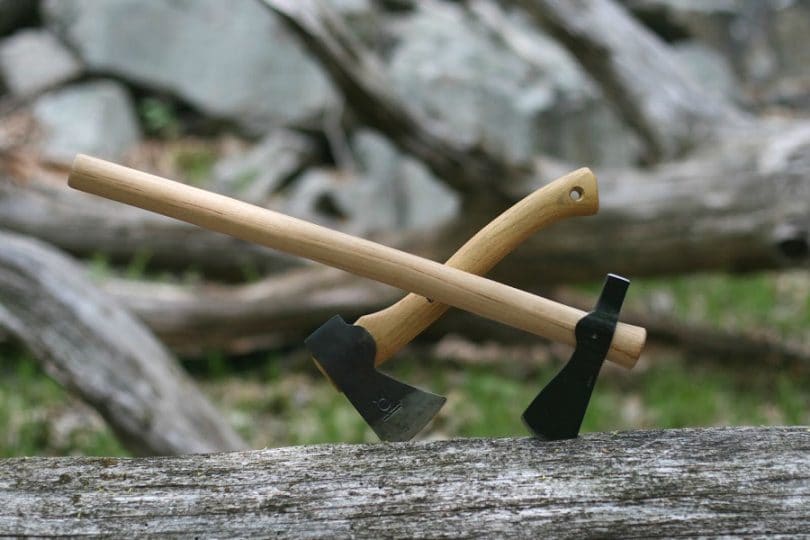
The new metal blades were far sturdier and far more efficient and could be fashioned into new designs, introducing spiked, hammer and pipe tomahawks.
Tomahawks were widely used by soldiers during the colonial era, both as a weapon and a tool, and continue to be carried by infantry units today, mainly for tactical uses, such as breaking down doors and rarely as a weapon.
While soldiers during colonial times often used tomahawks in hand to hand combat, throwing one at an enemy was the last resort, and one would aim just to hit the target, not necessarily with the bladed end.
Despite this, during that era soldiers and mountain men frequently practiced throwing their tomahawks in camp, or at trading fairs for entertainment and occasionally competition.
This is a tradition that is kept up today in the States, and many country fairs will involve a tomahawk throwing competition.
Nowadays, outside of military use and competitions, tomahawks are a great tool to take out into the wilderness on camping or hiking trips and are a great addition to any survival kit.
They perform a range of tasks and are smaller and lighter than other similar tools such as axes and hatchets, which are great for chopping wood but not a lot else. Throwing a hatchet or axe is far more difficult as well, as they are generally heavier and are not well balanced for throwing. See our expert review on how to choose the best axe for your reference.
Finally, modern tomahawks are made from a wider range of materials, with some still using a traditional wooden shaft, but other designs using a solid steel structure or plastics for the shaft. There are also some designed and weighted specifically for throwing.
When and Where to Throw Your Tomahawk
When and where you throw your tomahawk is dependent on several factors. Of course in this day and age, it is by far most common to throw your tomahawk for fun or in a competition.
For fun at camp: You may take a tomahawk or two with you when you go camping just for a bit of fun and for something to do while waiting for your food to cook for example.
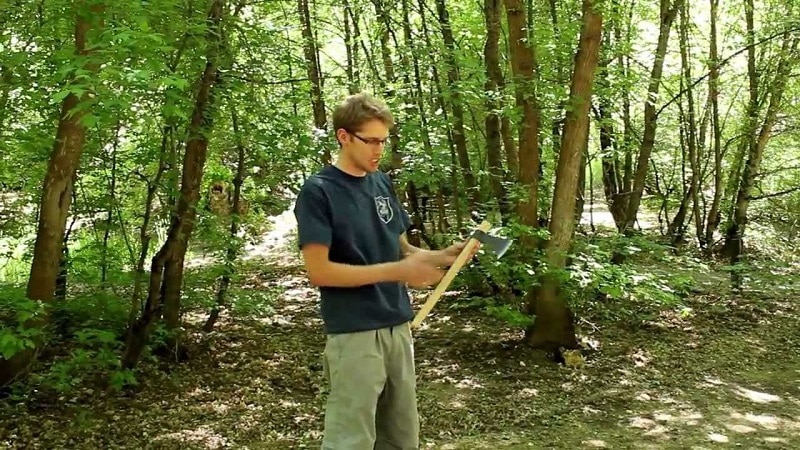
However, you may also find yourself in a tough situation, where you have been perhaps forced to camp in a less than ideal area due to injury or other unforeseen circumstances. In this case, a simple game or competition can be great for personal and group morale, and if conditions are cold, the activity will be especially good for you.
At a competition: There are a great many competitions held throughout the States that involve knife and “hawk” throwing, including some quite prestigious ones that will rank competitors globally.
Aside from larger competitions, many country fairs will include a hawk throwing competition. Who knows, perhaps you can win something?
Hunting: A confident and experienced tomahawk thrower can use his skill in order to take down a kill and provide dinner if needed.
While the practice isn’t all that common, in a survival situation it is good to have as many strings to your bow as possible and you may find yourself depending only on your tomahawk, which coincidentally can be used to skin and prepare the kill.
Self-defense: Despite the scenes in movies and TV shows, it really is very rare to throw a tomahawk at an enemy. For one thing, you are taking a huge risk and needlessly un-arming yourself if you miss.
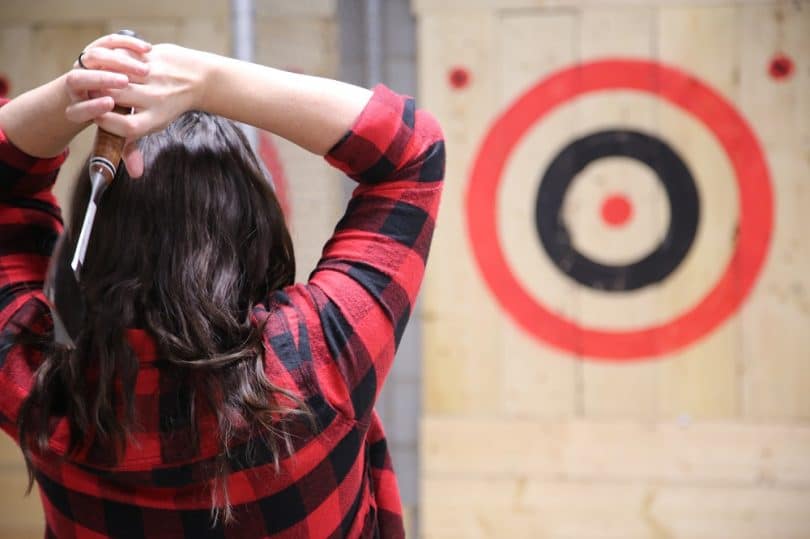
Secondly, unlike a stationary target, or prey you have snuck up on, an enemy is likely to be moving quickly and well aware of what you intend to do, making it far more difficult for your throw to hit true.
While it is extremely unlikely that you will need to throw a tomahawk at an enemy, nothing is impossible. However, your throw should be used as a means of distraction, don’t expect that the blade will sink in.
See also: Best Camping Hatchet: Our Top 8 Choices Reviewed
A hit from a spinning tomahawk is going to hurt regardless of whether the blade or the shaft hits you, and might just buy you enough time to escape or gain the advantage.
The circumstances in which you want to throw your tomahawk will greatly affect the type of hawk you will want to buy. There are several types;
- Spiked tomahawk
- Hammer tomahawk
- Tactical tomahawk
- Throwing tomahawk
- Double headed tomahawk
Within these subsections, there are other factors to consider, such as shaft length, weight, blade size and additional tools. If you’re throwing for sport and competition it is worth buying a tomahawk that is designed specifically for throwing, as these will be better balanced.
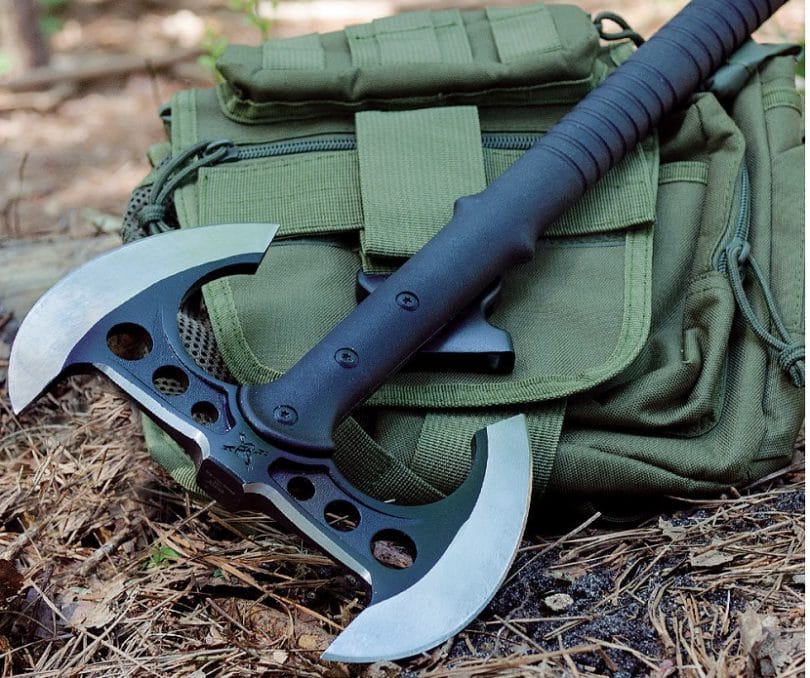
If you want to have some fun at camp, but also want a practical tool, a spiked, hammer even double edged tomahawk will be both practical and throwable. For hunting purposes, a double edged tomahawk can be good, as you have double the chance of the blade striking your target.
Finally, if you fear the worst and are preparing to arm yourself, or will rely on your tomahawk for survival situations, explore tactical tomahawk options.
Throwing safety
Before we go through the method for throwing a tomahawk, it’s worth discussing safety, as this is a hobby that could have disastrous results if something were to go wrong while you are practicing.
- Ensure that you have a suitable tomahawk
- Ensure you have a suitable target
- Ensure the area behind the target is clear
- Ensure the area behind and around you is clear
- Ensure you are suitable dressed
Using a suitable tomahawk
Ideally, a beginner should practice technique with a tomahawk designed for throwing.
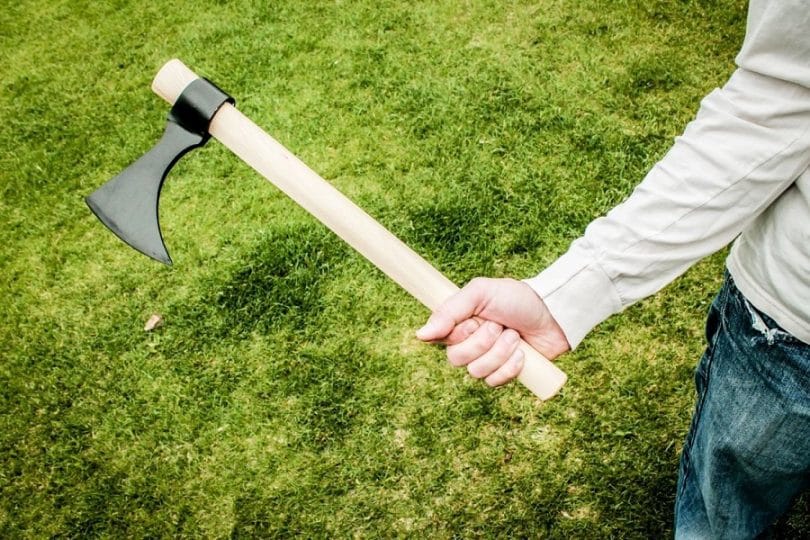
Not only will the improved balance aid your success, the absence of a pointed or sharp blade on the back of the head will reduce the risk of accidents if something goes wrong.
The length of the shaft and the weight are important, with most throwing hawks weighing a little less than 2 pounds and measuring in between 14 to 20 inches long.
- For an adult male, a 19” handle is generally recommended,
- for children a handle up to 16” works well
- for teens and women, look for a handle length of around 17 – 19”
The blade for a throwing tomahawk does not have to be razor sharp, and should even be a bit dull. When bought new, they will not have a sharp edge. This is the way they are designed, and they don’t need a razor-sharp edge to bite into the target.
It is the accuracy of the throw that ensures they will bite in and sharpening the edge does nothing other than increase the risk of accidents.
Using a suitable target
A good target for tomahawk throwing should be fairly large, preferably wooden and out in the open, with no danger of people walking behind it.
[the_ad_group id=”22″]
The most simple targets are dead, soft wood logs stuck vertically into the ground at least a foot deep, with the front face blazed to provide a flat target area.
Another good option is the cross section of a large, round, dead tree trunk, measuring at least 4 inches thick. This wood should be seasoned, so if it is freshly cut, you will need to leave it for a few months to dry.
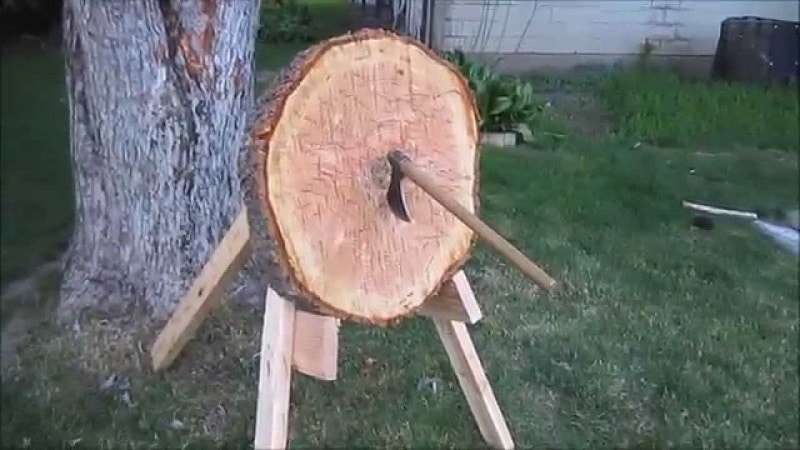
A tomahawk is more likely to stick into seasoned wood, whereas it is more likely to bounce off green wood. An alternative is to use large timber off cuts, measuring at least 30” wide and 4” thick.
Such off cuts can be picked up from your local timber yard or joiners workshop. You target should be well secured, especially if it will be off the ground.
A simple, tripod frame (think of an easel) can be constructed with basic woodworking skills and minimum tools. For additional security, you can install a backboard behind your target, so that if you miss your tomahawk won’t disappear into the woods, or into an unfortunate passerby.
This can be as simple as a wire fence secured between two poles, or for a more permanent structure, a stand-alone wooden construction can be built.
Avoid using live trees, as aside from cutting deeply into them and causing sap loss, the rounded profile is more likely to encourage the tomahawk to bounce off rather than stick in, which can be dangerous if it comes bouncing back at you or someone else.
Ensuring the area around you is clear
It is essential that you be sure that the entire area around you and the target are clear of people, animals, and fragile possessions. Even the most adept tomahawk throwers can make mistakes.
A sweaty hand can cause the hawk to slip from your grip at the wrong moment and can cause it to fly off in any direction. A distraction such as a wasp buzzing in your ear can also encourage premature release, with potentially disastrous consequences.
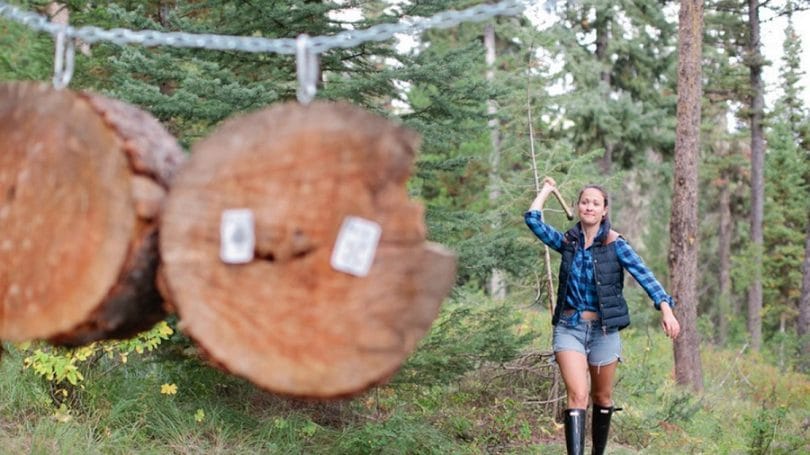
If you are throwing a tomahawk with your kids, take particular care and instruct them to stay well back when they are not throwing.
The safest areas are to the sides of the thrower, and slightly back. As previously mentioned, ensure that the target area is not in front of the path of passersby, or in front of your house, smashed windows and damaged hawk heads are just a few of the possible problems. A backboard can help with this.
Dress safely
While no amount of everyday clothing can save you if the tomahawk flies in your direction, you can take precautions when practicing your throw.
Sturdy, steel capped boots are recommended in case of a dropped hawk, or a late release as well as thick, long pants. Eye protection can be worn in case of flying splinters from the target.
Throwing technique
When discussing the best throwing techniques, we need to break down the method into smaller steps, before putting them together to complete a successful throw.
- Distance from the target
- How to hold the tomahawk
- Stance
- Throwing action
The distance from the target
The general principle when throwing a tomahawk is that you will stand far enough away from your target in order for the tomahawk to spin fully once. Twice is also achievable, and three spins are quite a feat, but not impossible.
The distance you stand from the target is the key factor when throwing a tomahawk successfully. You need to determine how much distance is required between yourself and the target, for the tomahawk to complete one full revolution.
For now we will focus only on one revolution, however, with experience, you will be able to throw from farther distances. The exact distance for the perfect throw differs for everybody, since arm length, tomahawk length, and the strength put into the throwing play a part, but there are some basic guidelines that will enable you to find the perfect distance for you.
- A general rule of thumb is that you should be standing between 12 and 14 feet away from the target. This equates to around five or six paces for most adults.
- The simplest way to measure the distance is to stand with your back against the target, and walk five paces. Draw a line or mark with a stick this distance.
- Take a step back and prepare to throw. When throwing you will take a step forward, so that your lead foot is on the line.
The first throw may not stick, but do not worry too much. We will have a look at what to do if the tomahawk doesn’t stick first time after we have covered the stance and the throwing technique.
How to hold a tomahawk for throwing
Before you throw the tomahawk it is important to know the best way to hold it.
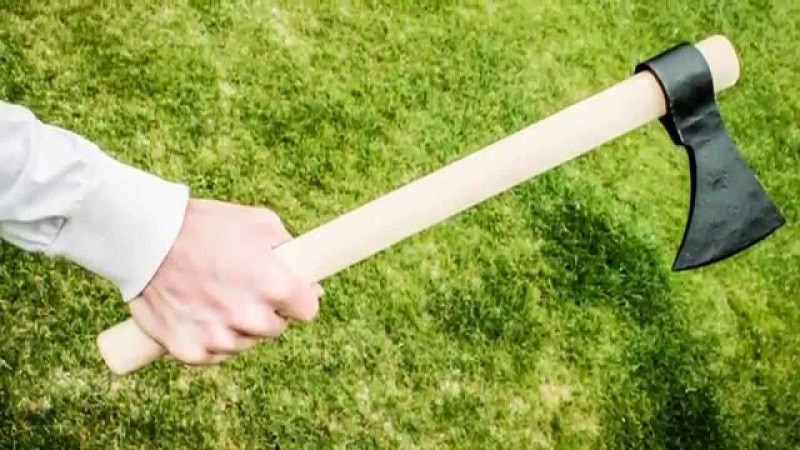
Not only will this allow you to throw it with more ease and accuracy, but it is also safer as you are less likely to drop it or throw it in the wrong direction by mistake.
- When someone hands you a tomahawk shaft first, imagine you are shaking someone’s hand.
- Use this handshake grip to firmly grasp the bottom of the handle. Hold it as you would a hammer.
- Your thumb should wrap to the side, and over your fingers. Don’t put your thumb on top of the handle, as if giving a thumbs up, as this will change the axis point and cause your tomahawk to spin later.
- The cutting blade should be pointed to the ground.
- Ensure the tomahawk’s cutting edge is perfectly straight in your hand. If it is off center it will wobble while in the air and is unlikely to stick. Loosen your grip slightly and allow the hawks weight, and gravity to correct itself.
Once you have a good grip on the tomahawk, it is time to move into the correct stance.
The stance
The next step after initially marking out the distance and with your hawk in hand is to stand correctly in order to safely and accurately throw your hawk.
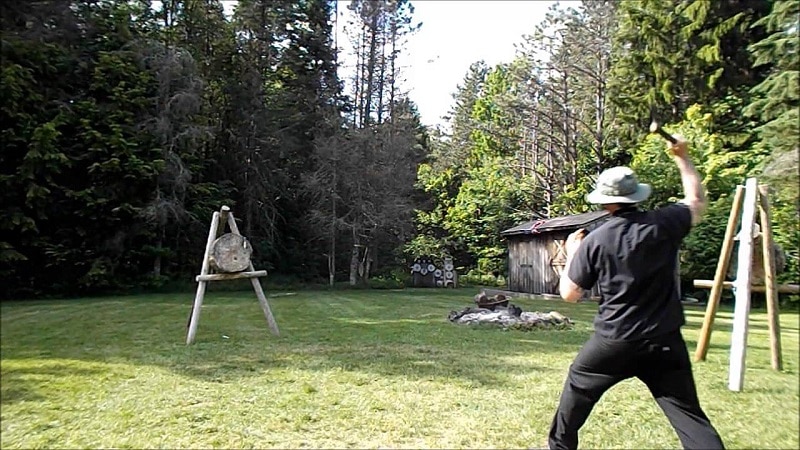
There are several stances you could adopt, however, we will cover just a basic stance here that will enable you to throw with a decent amount of force.
- Take one step back from your line. Stand with your feet shoulder-width apart and your back straight.
- Face your target square on and hold the hawk, cutting edge down, at your side.
- If you’re throwing with your right hand, put your left leg forward so that your toes touch the line. If you’re throwing with your left hand, put your right foot forward.
By now you should be at the correct distance from your target, gripping your tomahawk firmly and safely and standing ready to throw.
The throwing action
Finally, after all the other pieces are in place, you can throw your tomahawk.
- With your tomahawk at your side, first raise your throwing arm straight in front of you in order to be sure your aim is true.
- You can lower your arm back to your side or go to the next step from here depending on what is more comfortable for you.
- Now, keeping your arm straight, and not fully bending the elbow, swing the throwing arm over your shoulder so that your arm is more or less pointing straight up to the sky.
- Quickly swing the arm back down again, keeping it straight.
- Release your grip on the tomahawk when your arm is almost horizontal. Imagine you’re offering your hand for a handshake again, with fingers pointing forward.
- Ensure you follow through so that your arm returns to your side for the best results.
This should be done in a quick, fluid motion, keeping your back straight, wrist locked and throwing from the arm, ensuring that your arm is kept pretty much straight the entire time. All going well, your hawk should spin through the air and sink into the target.
There are as mentioned earlier several variations, but as a beginner, this is a great way to start out and practice makes perfect. Once you have mastered this technique you can explore variations.
Troubleshooting and how to fix a throw that doesn’t stick
It is not uncommon as a beginner that on the first try the hawk will not sink into the target. This is generally due to the distance being slightly off and can be easily put right. First of all you need to pay attention to how your tomahawk is hitting the target.
- If the top of the head hits first, it means you are standing too far back, and the hawk has completed one full revolution before it has hit the target.
- If the shaft hits the target first, it means you are standing too close and the hawk hasn’t fully completed a revolution.
Adjust the distance accordingly, by taking a half step back or forward and try again. If it sticks you have found the distance that is right for your tomahawk.
This distance, in theory, should work for most people throwing a tomahawk that is the same length. Be sure to mark this new distance, and keep on practicing.
If it sticks sometimes, but bounces off more often, check that your wrist is locked when throwing and that the tomahawk is centered and straight before throwing.
Variations and games
It is important to practice the above method at a shorter distance until you are able to get your hawk to stick in 99 percent of the time.
After a while, you will find that you don’t need to mark out the distance so precisely and that you are better able to judge the necessary distance by eye, and your body will compensate for minor miscalculations. Once you have reached this level you can begin trying to throw at further distances.
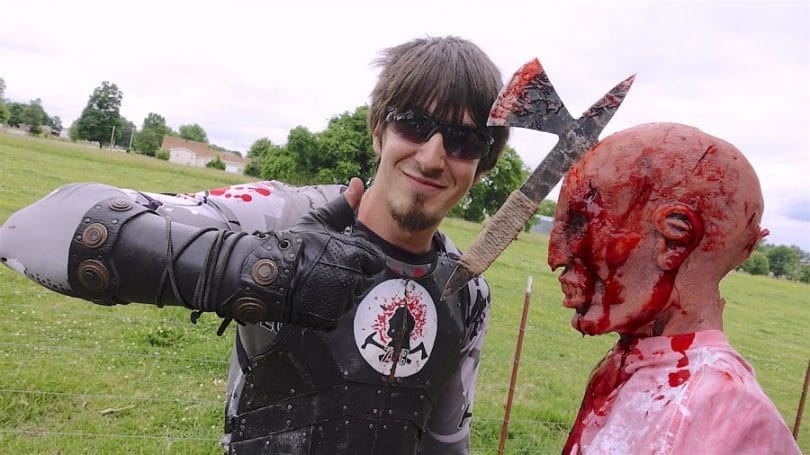
Find your initial distance line and double it to create more of a challenge. The tomahawk will have to rotate two full times in order to stick to the target. You can also throw at half rotation distances, by holding the hawk with the cutting edge up and standing one and a half rotations away from your target. The handle will stick upwards in this case.
Obviously, this will take some practice to get the distances correct, but it is useful to be able to throw at a variety of distances, especially when hunting. Another variation of the throwing technique is to throw underarm, which can be useful is space is an issue.
[the_ad_group id=”23″]
For a more interesting competition with friends, or simply to improve your accuracy you can use playing cards stuck onto the target and aim for specific cards. You can even play a tomahawk version of darts if your target is painted appropriately.
Time to Throw
With the above guide, you are now prepared to get out there and practice your technique until you become a master.
Who knows, you might be the next world champion tomahawk thrower. Practice makes perfect and you’ll soon find that you are able to accurately judge the necessary distance you need to stand in order to hit your target each time.
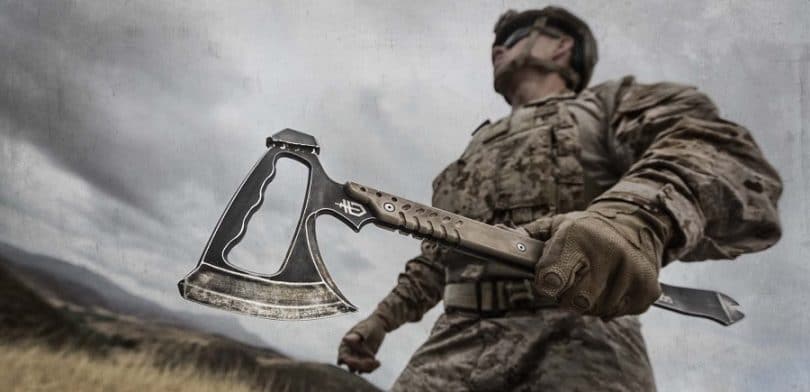
It’s a fun skill to know and might also be very useful in a survival situation. Just remember, aside from a fun pastime, tomahawks can be very useful tools and your survival kit will certainly be enhanced by the addition of one, but if you are throwing them, safety and consideration are paramount, even seasoned throwers have had near misses. For more information and review of the top tomahawks, see our article on this important topic.
Do you throw a tomahawk? What’s your technique or favorite game? Let us know in the comments below.







In my opinion for the vast majority of survival situations, whether it be camping, backpacking hiking or hunting, a tomahawk in this day and age, is perhaps a poor choice of tool. You’d be much better served by a quality survival knife, a lightweight saw or even a hatchet. They will prove to be far more functional and versatile than a tomahawk.
While tomahawks have been used for hunting for decades, you have to be incredibly skilled and have an awful lot of patience to be successful, beyond this, their other application value is minimal, for example, they’re not the best and things like chopping wood.
I believe that those who carry them do so primarily for entertainment purposes or as a tactical weapon in self-defence situations.
I have to disagree somewhat. There are no all-in-one survival tools that will do absolutely everything you need, you’re always going to need something else. Though I do agree that the tomahawk is particularly good for entertainment, and yes, this is probably its primary use today, I still believe there are actually some positives and benefits to carrying one over the likes of a hatchet or axe.
Unless you’re heading out into the woods with the intention of chopping down trees, you should be able to get away with a tomahawk for basics, such as preparing firewood. Tomahawks are usually much lighter than hatchets and axes, so easier to carry. If you choose a two piece design, the handle is easier to replace in the field and the head can be easily removed to function as a temporary Ulu or chisel. They are incredibly simple to sharpen and the narrower blade is good for more intricate tasks.
A rather versatile tool in my humble opinion.
I agree, Adam. It is a matter of subjective preference that will determine if the tomahawk will work for you or not. Tomahawks in general are more ergonomic than axes or hatchets, and a you’ve mentioned, they are also way lighter. Sharpening is also a breeze when it comes to tomahawks.
This is quite subjective, James, because I spoke with a lot of hikers and campers and they actually see tomahawks as a very versatile tool. It really depends on the user because tomahawks, when properly utilized can be a defensive and offensive tool for outdoor needs.
In my opinion for the vast majority of survival situations, whether it be camping, backpacking hiking or hunting, a tomahawk in this day and age, is perhaps a poor choice of tool. You’d be much better served by a quality survival knife, a lightweight saw or even a hatchet. They will prove to be far more functional and versatile than a tomahawk.
While tomahawks have been used for hunting for decades, you have to be incredibly skilled and have an awful lot of patience to be successful, beyond this, their other application value is minimal, for example, they’re not the best and things like chopping wood.
I believe that those who carry them do so primarily for entertainment purposes or as a tactical weapon in self-defence situations.
I have to disagree somewhat. There are no all-in-one survival tools that will do absolutely everything you need, you’re always going to need something else. Though I do agree that the tomahawk is particularly good for entertainment, and yes, this is probably its primary use today, I still believe there are actually some positives and benefits to carrying one over the likes of a hatchet or axe.
Unless you’re heading out into the woods with the intention of chopping down trees, you should be able to get away with a tomahawk for basics, such as preparing firewood. Tomahawks are usually much lighter than hatchets and axes, so easier to carry. If you choose a two piece design, the handle is easier to replace in the field and the head can be easily removed to function as a temporary Ulu or chisel. They are incredibly simple to sharpen and the narrower blade is good for more intricate tasks.
A rather versatile tool in my humble opinion.
I agree, Adam. It is a matter of subjective preference that will determine if the tomahawk will work for you or not. Tomahawks in general are more ergonomic than axes or hatchets, and a you’ve mentioned, they are also way lighter. Sharpening is also a breeze when it comes to tomahawks.
This is quite subjective, James, because I spoke with a lot of hikers and campers and they actually see tomahawks as a very versatile tool. It really depends on the user because tomahawks, when properly utilized can be a defensive and offensive tool for outdoor needs.
I just enjoy throwing things. If it isn’t a basketball, then it’s anything else that can be thrown. I was always fascinated by people who threw tomahawks with surgical precision. Following their example I tried to learn it on my own. It was difficult at first but after a lot of practicing I managed to ‘feel’ where and how the tomahawk is going to land. My brother and I competed who was more accurate. Then one day our mum found out about activity and we were back to playing basketball…
Throwing a tomahawk requires a considerable amount of concentration because it uses a lot of arm strength and movement. Practicing a lot will definitely take you far as this establishes your very own technique, momentum, and balanced throw.
I just enjoy throwing things. If it isn’t a basketball, then it’s anything else that can be thrown. I was always fascinated by people who threw tomahawks with surgical precision. Following their example I tried to learn it on my own. It was difficult at first but after a lot of practicing I managed to ‘feel’ where and how the tomahawk is going to land. My brother and I competed who was more accurate. Then one day our mum found out about activity and we were back to playing basketball…
Throwing a tomahawk requires a considerable amount of concentration because it uses a lot of arm strength and movement. Practicing a lot will definitely take you far as this establishes your very own technique, momentum, and balanced throw.